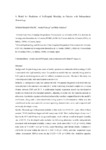A model for prediction of in-hospital mortality in patients with subarachnoid hemorrhage

Use este enlace para citar
http://hdl.handle.net/2183/30998Coleccións
- Investigación (FCS) [1293]
Metadatos
Mostrar o rexistro completo do ítemTítulo
A model for prediction of in-hospital mortality in patients with subarachnoid hemorrhageData
2020-07-15Cita bibliográfica
Mourelo-Fariña M, Pértega S, Galeiras R. A model for prediction of in-hospital mortality in patients with subarachnoid hemorrhage. Neurocrit Care. 2021 Apr;34(2):508-518.
Resumo
[Abstract] Background: Despite being a rare cause of stroke, spontaneous subarachnoid hemorrhage (SAH) is associated with high mortality rates. The prediction models that are currently being used on SAH patients are heterogeneous, and few address premature mortality. The aim of this study was to develop a mortality risk stratification score for SAH.
Methods: A retrospective study was carried out with 536 patients diagnosed with SAH who had been admitted to the intensive care unit (ICU) at the University Hospital Complex of A Coruña (Spain) between 2003 and 2013. A multivariate logistic regression model was developed to predict the likelihood of in-hospital mortality, adjusting it exclusively for variables present on admission. A predictive equation of in-hospital mortality was then computed based on the model's coefficients, along with a points-based risk-scoring system. Its discrimination ability was also tested based on the area under the receiver operating characteristics curve and compared with previously developed scores.
Results: The mean age of the patients included in this study was 56.9 ± 14.1 years. Most of these patients (73.9%) had been diagnosed with aneurysmal SAH. Their median length of stay was 7 days in the ICU and 20 days in the general hospital ward, with an overall in-hospital mortality rate of 28.5%. The developed scales included the following admission variables independently associated with in-hospital mortality: coma at onset [odds ratio (OR) = 1.87; p = 0.028], Fisher scale score of 3-4 (OR = 2.27; p = 0.032), Acute Physiology and Chronic Health Evaluation II (APACHE II) score within the first 24 h (OR = 1.10; p < 0.001), and total Sequential Organ Failure Assessment (SOFA) score on day 0 (OR = 1.19; p = 0.004). Our predictive equation demonstrated better discrimination [area under the curve (AUC) = 0.835] (bootstrap-corrected AUC = 0.831) and calibration properties than those of the HAIR scale (AUC = 0.771; p ≤ 0.001) and the Functional Recovery Expected after Subarachnoid Hemorrhage scale (AUC = 0.814; p = 0.154).
Conclusions: In addition to the conventional risk factors for in-hospital mortality, in our study, mortality was associated with the presence of coma at onset of the condition, the physiological variables assessed by means of the APACHE II scale within the first 24 h, and the total SOFA score on day 0. A simple prediction model of mortality was developed with novel parameters assessed on admission, which also assessed organ failure and did not require a previous etiological diagnosis.
Palabras chave
In-hospital mortality
Prediction model
Score
Spontaneous subarachnoid hemorrhage
Prediction model
Score
Spontaneous subarachnoid hemorrhage
Versión do editor
Dereitos
This version of the article has been accepted for publication, after peer review and is subject to Springer Nature’s AM terms of use, but is not the Version of Record and does not reflect post-acceptance improvements, or any corrections. The Version of Record is available online at Springer Link.
ISSN
1541-6933





